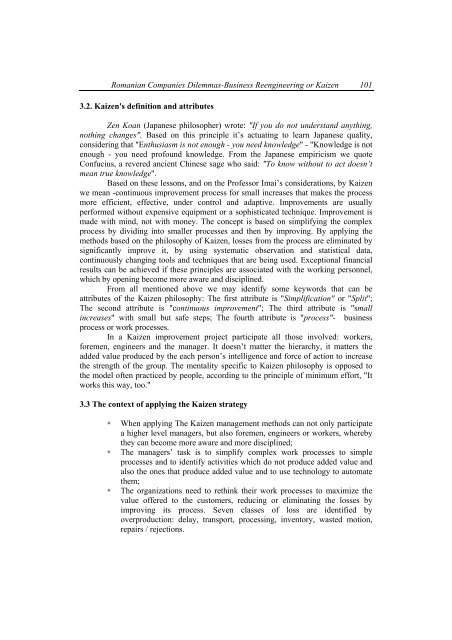annals of the university of petroÅani â¼ economics â¼ vol. xi - part i ...
annals of the university of petroÅani â¼ economics â¼ vol. xi - part i ...
annals of the university of petroÅani â¼ economics â¼ vol. xi - part i ...
You also want an ePaper? Increase the reach of your titles
YUMPU automatically turns print PDFs into web optimized ePapers that Google loves.
Romanian Companies Dilemmas-Business Reengineering or Kaizen 101<br />
3.2. Kaizen's definition and attributes<br />
Zen Koan (Japanese philosopher) wrote: "If you do not understand anything,<br />
nothing changes". Based on this principle it’s actuating to learn Japanese quality,<br />
considering that "Enthusiasm is not enough - you need knowledge" - "Knowledge is not<br />
enough - you need pr<strong>of</strong>ound knowledge. From <strong>the</strong> Japanese empiricism we quote<br />
Confucius, a revered ancient Chinese sage who said: "To know without to act doesn’t<br />
mean true knowledge".<br />
Based on <strong>the</strong>se lessons, and on <strong>the</strong> Pr<strong>of</strong>essor Imai’s considerations, by Kaizen<br />
we mean -continuous improvement process for small increases that makes <strong>the</strong> process<br />
more efficient, effective, under control and adaptive. Improvements are usually<br />
performed without expensive equipment or a sophisticated technique. Improvement is<br />
made with mind, not with money. The concept is based on simplifying <strong>the</strong> complex<br />
process by dividing into smaller processes and <strong>the</strong>n by improving. By applying <strong>the</strong><br />
methods based on <strong>the</strong> philosophy <strong>of</strong> Kaizen, losses from <strong>the</strong> process are eliminated by<br />
significantly improve it, by using systematic observation and statistical data,<br />
continuously changing tools and techniques that are being used. Exceptional financial<br />
results can be achieved if <strong>the</strong>se principles are associated with <strong>the</strong> working personnel,<br />
which by opening become more aware and disciplined.<br />
From all mentioned above we may identify some keywords that can be<br />
attributes <strong>of</strong> <strong>the</strong> Kaizen philosophy: The first attribute is "Simplification" or "Split";<br />
The second attribute is "continuous improvement"; The third attribute is "small<br />
increases" with small but safe steps; The fourth attribute is "process"- business<br />
process or work processes.<br />
In a Kaizen improvement project <strong>part</strong>icipate all those in<strong>vol</strong>ved: workers,<br />
foremen, engineers and <strong>the</strong> manager. It doesn’t matter <strong>the</strong> hierarchy, it matters <strong>the</strong><br />
added value produced by <strong>the</strong> each person’s intelligence and force <strong>of</strong> action to increase<br />
<strong>the</strong> strength <strong>of</strong> <strong>the</strong> group. The mentality specific to Kaizen philosophy is opposed to<br />
<strong>the</strong> model <strong>of</strong>ten practiced by people, according to <strong>the</strong> principle <strong>of</strong> minimum effort, "It<br />
works this way, too."<br />
3.3 The context <strong>of</strong> applying <strong>the</strong> Kaizen strategy<br />
• When applying The Kaizen management methods can not only <strong>part</strong>icipate<br />
a higher level managers, but also foremen, engineers or workers, whereby<br />
<strong>the</strong>y can become more aware and more disciplined;<br />
• The managers’ task is to simplify complex work processes to simple<br />
processes and to identify activities which do not produce added value and<br />
also <strong>the</strong> ones that produce added value and to use technology to automate<br />
<strong>the</strong>m;<br />
• The organizations need to rethink <strong>the</strong>ir work processes to ma<strong>xi</strong>mize <strong>the</strong><br />
value <strong>of</strong>fered to <strong>the</strong> customers, reducing or eliminating <strong>the</strong> losses by<br />
improving its process. Seven classes <strong>of</strong> loss are identified by<br />
overproduction: delay, transport, processing, inventory, wasted motion,<br />
repairs / rejections.

















